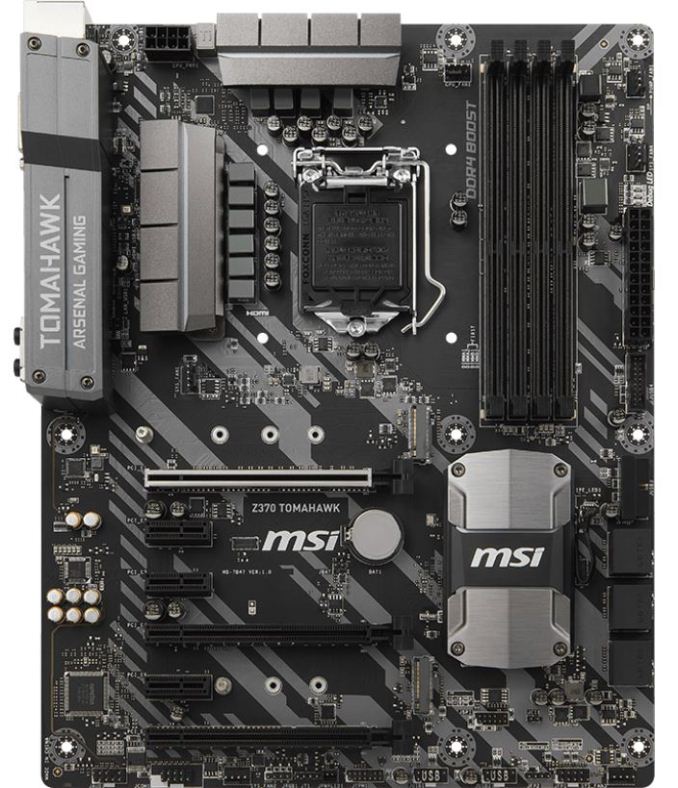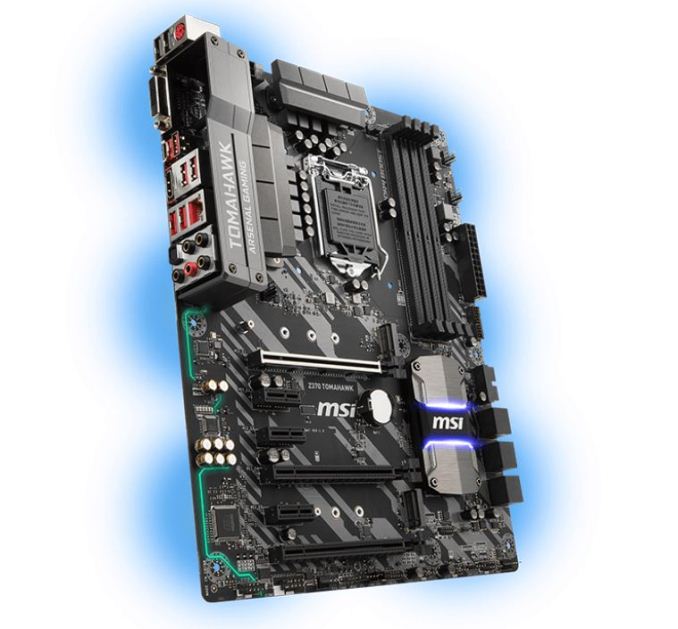Analyzing Z370 for Intel's 8th Generation Coffee Lake: A Quick Look at 50+ Motherboards
by Ian Cutress, Anton Shilov, Joe Shields & Gavin Bonshor on October 20, 2017 2:00 PM ESTMSI Z370 Tomahawk
The MSI Z370 Tomahawk positions itself as a mid-range gaming board from the 'Arsenal Gaming' lineup (boards that have weapon-based names). The Arsenal lineup, like the Performance and the Enthusiast lines, is aimed towards hardcore gamers, including eSports participants. As such, the boards in this category are tested to go through 24 hours of testing both offline and online gaming by eSports players. Obviously, not all boards are tested in this way, but likely a few were before mass production (though to be honest, if they fail that test, there are serious issues wrong).
The look of the Tomahawk differs from the Enthusiast gaming series boards from MSI. Both use a black PCB, but the VRM heatsinks on the Tomahawk are redesigned and looks to be a bit smaller. The shroud for the back panel looks different as well, going for a more military look. The PCH heatsink is styled differently, similar to an SLI HB bridge even though this board does not support SLI, and has the MSI name in the middle with an LED illuminating the heatsink. The remaining RGB LEDs are on the audio separation line and the back of the board, giving it more of a backlit glow when inside of a case. There is also some gray stenciling on the board. If more RGB LEDs are in the future, the Tomahawk does have one additional RGB LED connector. Of the three PCIe slots, the first one for graphics cards is steel reinforced.
The memory capacity across the four memory slots sits at 64GB, while speeds on the Tomahawk are rated up to DDR4-4000 through MSI’s DDR4 Boost. There are a total of three full-length PCIe slots, with the first one being fortified by MSI’s Steel Armor and coming from the processor. The other two are x4 and x1 slots from the chipset, and between the three full-length slots are another three PCIe x1 slots powered by the chipset.
The Tomahawk includes six SATA ports supporting RAID 0, 1, 5, and 10. The ports are all located to the right of the chipset and face the edge of the board. The board has two M.2 slots, with the first above the top PCIe slot and able to hold up to a 110mm drive. The 2nd M.2 slot is mounted between the two full-length black PCIe slots and holds up to an 80mm drive. A total of six fan connectors can be found on the board around the CPU socket, two in the upper right-hand corner, a couple on the bottom of the board, and another below the VRM heatsink on the left side. Audio duties are handled by the older Realtek ALC9892 codec, which uses Chemicon audio capacitors. The audio chipset itself does not appear to be EMI shielded, however there is board separation between the analog and digital parts of the system. A single Intel I219-V gigabit Ethernet controller is also present.
Support for USB 3.1 (10 Gbps) comes from the ASMedia ASM3142 controller and gives one Type-C port and one Type-A port, both located on the back panel. Four USB 3.1 (5 Gbps) ports and two USB 2.0 ports are also on the back panel, with two headers of each type on the board. The remainder of the back panel consists of a PS/2 port, DVI-D and HDMI video outputs, the Intel network controller, and an audio jacks plus SPDIF.













83 Comments
View All Comments
sor - Friday, October 20, 2017 - link
Damn. At least key it differently and call it LGA1151v2 or something.The changes are so minimal it really does seem like planned obsolescence. Does it really need more power pins to support new chips with the same power envelopes? Really? They couldn’t handle that on the CPU PCB?
KaarlisK - Saturday, October 21, 2017 - link
Actually it is ~1.5 times peak current with the same average power envelope, so yes, they need the change.If they had not brought the launch forward and just launched together with the cheap chipsets, there would be far less complaints.
sor - Saturday, October 21, 2017 - link
Where did you find information indicating current has increased 50%? I just spent about ten minutes trying to find a reference backing that up, perhaps something indicating the 8 series operates at a much lower voltage within same TDP, which would translate to higher current but they seem to operate in the same 1.2-1.3v range.You’re not just assuming they draw more current because they have two more cores, are you?
KaarlisK - Sunday, October 22, 2017 - link
Notice the difference between average and peak.And the information is in publicly available documents. I did not bother to look it up, but others have, for example: https://forum.beyond3d.com/threads/intel-coffee-la...
Crono - Saturday, October 21, 2017 - link
Nice roundup. That's a lot of motherboards to spec and summarize. I especially appreciate the handy chart at the end, it's a good, quick-and-dirty comparison tool.Landcross - Saturday, October 21, 2017 - link
You guys forgot 2 new Z370 boards from Supermicro :)https://motherboarddb.com/motherboards/?chipset=19...
Xpl1c1t - Sunday, October 22, 2017 - link
The mITX board looks incredible.+ Low ESR Tantalum capacitors! (first time seeing them on VRM duty on a mainboard)
+ HDMI 2.0
+ 2x M.2 Slots
+ USB 3.1 Type C
+ Optical SPDIF
- RGB.......
MadAd - Saturday, October 21, 2017 - link
Great write up but for me its just another depressing generation of oversized, overpriced ATX form factor offerings on which the vast majority of users wont even plug a second gpu into, with the smaller and more size appropriate FF represented as a minority afterthought.With all the progress of PCs since the 90s whod have thought that I could still use the same ATX case today while every single other component (from floppy drives to 2d Mattrox cards) have long gone to the recyclers. I find it so annoying how manufacturers have stuck on this prehistoric gargantuan case size with the other sizes being an afterthought. It feels like like stifled innovation while everything else is moving on.
rocky12345 - Saturday, October 21, 2017 - link
Great article and a lot of work put in to get it out for us to read thank you.My only issue is and it is nit your fault is why these companies feel the need to totally blanket the market with basically the same boards just a different model number and basically a few tiny changes and spray paint it a different color and use the word gaming and put something x or x1 or k,k3 etc etc. For crap sakes just release three models not 7-10 models of the same crap it is pretty much just greed I guess.
The whole market is like this now with anything computer related of and if it has the words GAMING or RGB in it's got to be good for sure. My fav is that gaming mouse pad next it will have RGB lighting in it...lol
CitizenZer0 - Wednesday, October 25, 2017 - link
Agreed